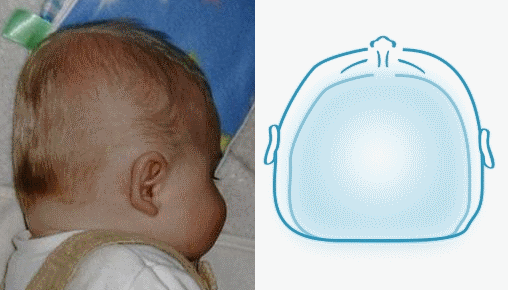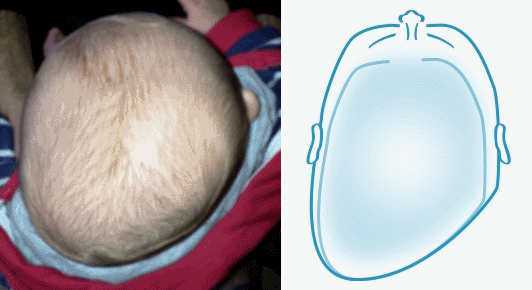
So what are plagiocephaly and brachycephaly? This blog post establishes the key differences between brachycephaly and plagiocephaly, so you can take the next steps in finding the right treatment.
Plagiocephaly vs Brachycephaly
Brachycephaly

Pronounced brack-ee-kef-alley, the condition refers to a head shape that is disproportionately wide compared to the depth.
If your baby has brachycephaly, at about eight weeks, you may notice that the flattening appears across the back of the skull, causing the head shape to appear much wider than usual. You may also notice that the back of the head may be taller than normal and in some cases, this may cause a bulging in the brow area towards the front of the skull. Our blog post explains the 4 indications of a brachycephalic head shape.
Brachycephaly is usually seen in the first few months of a baby’s life when the skull is still soft, malleable and susceptible to external pressures. There are a number of causes of the condition, identified in this informative blog post which explains brachycephaly in more detail and how the condition can be effectively treated. Active steps are required in order to prevent the deformity from getting worse or becoming permanent.
Plagiocephaly

Pronounced play-jee-oh-kef-alley, plagiocephaly is the most common type of flat head syndrome and refers to an asymmetrical head shape with a flattening to one side of the head. Often compared to the shape of a parallelogram, an oblique slant appears on the surface of the skull with the flattening appearing on either the left or right side.
Classifying the severity of plagiocephaly can be difficult without carrying out a clinical assessment. However, the most common form of plagiocephaly is diagnosed as positional Plagiocephaly. There are a number of other symptoms to look out for aside from the flattening and these include:
- Misalignment of the ears. This happens as a result of the ears and cheeks being pushed forward on the flatter side of the head.
- Facial asymmetry and the eyes differing in size and position (one eye can appear lower or smaller than the other eye). This can also cause the brow area to bulge outwards.
- A combination of brachycephaly and plagiocephaly can also commonly be found together, presenting itself as a wide, asymmetric head shape.
What are the Causes of Plagiocephaly and Brachycephaly?
Although there are key differences between plagiocephaly and brachycephaly, many of the babies we see at our clinics throughout the UK have a combination of the two. This doesn’t mean that your baby is suffering from two separate conditions but that the terms used are clinical expressions to describe the characteristics of flattening of your baby’s head.
Even with their differences, both conditions can be caused by a number of factors, including the following, which are most common:
- Softened skull – Babies are born with incredibly soft skulls which enable them to pass through the birth canal and accommodate the rapid brain growth that occurs during the first few months of life. As bone plates in babies’ skulls do not fuse until toddler age, this makes them highly susceptible to shape-change from a variety of factors- the position of the baby in the womb being just one of them.
- Multiple births –Flat head syndrome is common in multiple births as there is less room for infants to move around, placing added pressure on the soft bones of the skull.
- Premature birth – Premature babies are also particularly susceptible to flat head syndrome as they don’t benefit from the bone mineralisation that occurs during the final few weeks of pregnancy. Additionally, premature babies can sometimes prefer to rest their head on one side as they are not yet able to move their head themselves, and because their skulls are even softer than full-term babies.
- After birth – Pressure on the head after birth is one of the most common plagiocephaly causes, particularly where a lot of time is spent resting the head against flat surfaces. This problem is made worse by conditions like torticollis, a tightening of the neck muscle on one side, which can be treated through physiotherapy.

What Treatment is Available for Plagiocephaly or Brachycephaly?
Although flat head syndrome is the umbrella term for the condition, it can be easy to define every flattening as such. This often leaves parents feeling confused and nervous at the thought of treating the condition as they have no real clarification of their baby’s condition.
We recommend that parents start repositioning as soon as a flattening becomes apparent. This can help prevent plagiocephaly and brachycephaly from getting worse and may even assist in its reversal. If any improvement can be achieved naturally, it will be during the first few weeks of life, usually up until around four months of age.
When sleeping – Put baby on their back to sleep and alternate the end of the cot they sleep in to encourage sleep on different sides of the head. Move baby’s nightlight to different sides of the room (babies tend to follow light with their eyes, and consequently their head – make sure this isn’t always in one direction), and make sure to check and change their head’s positioning when sleeping if necessary, away from the flattened side.
When playing – Engage in tummy time to strengthen important neck and trunk muscles. While awake, on a firm and flat surface, place baby on their front. This will also aid development and coordination. As leaving a baby on their back for too long can create similar pressure to FHS on the back, tummy time reduces this too.
When feeding and carrying – Switch up the side you hold baby, to encourage equal movement between both sides of baby’s head.
When travelling – If possible, limit time spent with baby in car seats and buggies, where their head will rest on a firm flat surface for prolonged periods of time. Furthermore, use a sling or front carrier rather than walking your baby in their car seat.
Next Steps for Plagiocephaly and Brachycephaly
We understand that there is often poor and conflicting advice online, and that’s why we offer a free, no-obligation clinical assessment of your child. We aim to provide reassurance and clear guidance at what can be a difficult time, rather than seeking to take advantage of your distress. We can give you a clear and honest appraisal of your baby’s needs because without knowing where you are starting, it’s impossible to know where you’re heading. We always quantify every individual head shape so that we know just where to allow the head to grow and correct itself.
Our experience is that if the plagiocephaly and brachycephaly are not improving on its own by five months of age, it probably won’t improve at all without further assistance. In these cases, our unique TiMbandAir treatment can be used to gradually remould the head back to a more normal, symmetrical shape.
This treatment is completely painless and takes between three and six months to complete, depending on the degree of deformity and the age of the baby. Its extraordinary success rate can be seen in the thousands of babies we have treated to date – find us on Facebook for some recent stories, and to follow patient stories. At Technology in Motion, we can guarantee that once your baby has completed TiMbandAir treatment, plagiocephaly will not return, and your baby’s head shape will not revert to its pre-treatment shape.
We usually have over 100 infants in treatment at any one time and are widely regarded as a leading clinical team in the management of flat head syndrome. To book a free, no-obligation assessment at your nearest clinic, call 0330 100 1800 or fill in our contact form today.


